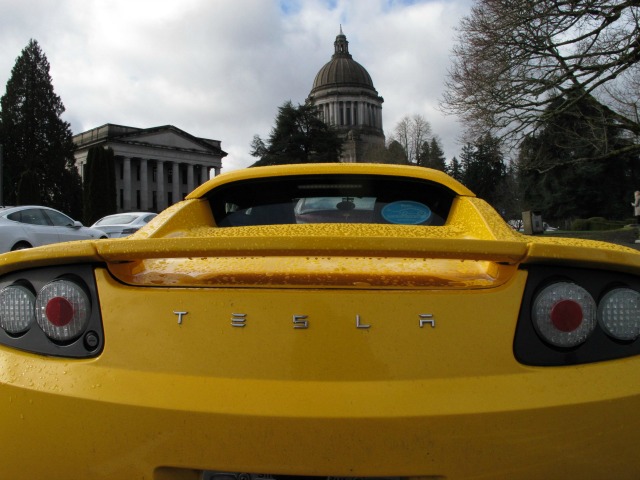
Tesla Motors mined middle class taxpayers for a $495 million loan to build a subsidized car in California for uber-wealthy elitists to thumb their noses from the car-pool lane at the peasants in the low class lanes. Now they want another slurp at the taxpayers’ trough for subsidies to finance, build, and operate a $5 billion, 6,500-employee battery factory.
After playing off Arizona, New Mexico, Nevada, and Texas to maximize the level of subsidy offers, Tesla is actively shaking down California for even bigger crony capital subsidies. With Tesla’s chairman Elon Musk never really risking a dime of his own money, Tesla wants to think big, as long as California takes all the risk.
As the chairman of Tesla, Elon Musk is the consummate post-capitalism entrepreneur. With a net worth at $8.2 billion estimated by Forbes, Musk regularly taps the government to pay for the research, financing, and on-going subsidies for his new ventures. Besides the Tesla Motors Inc. subsidy machine, Musk is also the chairman of SolarCity, which slurps huge amounts of utility credits as the largest U.S. installer of Chinese rooftop solar panels, and as the chairman of SpaceX, where he has a lucrative single source contract to ferry cargo to the International Space Station for NASA.
Besides getting the federal government’s money, Musk and Tesla also mined the Golden State’s taxpayers for cash. The California Energy Commission spent $10 million to upgrade Tesla’s factory in Fremont, paid $650,000 to train Tesla factory workers, and waived about $8 million in sales taxes for the $90 million in equipment Tesla purchased. The California Air Resources Board has given $16.8 million in rebates to Tesla and continues to offer new buyers a $2,500 rebate. Furthermore, the Legislature also granted Tesla drivers the right to drive in the car pool lanes by themselves. This privilege explains why California had more than a third of all Tesla sales.
Most people just assume that Tesla got all its crony capital support because of the Obama Administration’s and the California Legislature’s commitment to organized labor. But Musk has never allowed unions to organize any of his companies’ workers. The United Auto Workers‘ union President Bob King told an auto industry website he had set up an organizing committee at the Tesla factory in Northern California and met with Elon Musk in August. After the meeting, Musk made a high visibility show of testing the waters to build his battery factory in non-union Texas and Arizona.
Last summer Musk said he was now opposed to subsidies when he tweeted that government should no longer provide such assistance, because a “carbon tax would be a better way.” Of course, Tesla would be exempt from that carbon tax and their competitors would be forced to pay $3-5,000 per car they sold. Musk piously opined: “Yes, am arguing against subsidies and in favor of a tax on the end bad created. Market will then achieve best solution.”
But Tesla’s annual report states: “Our growth depends in part on the availability and amounts of government subsidies and economic incentives for alternative fuel vehicles generally and performance electric vehicles specifically.” Tesla’s website adds, “U.S. Bank and Wells Fargo will finance the majority of Model S. In most cases, federal and state tax credits ranging from $7,500 to $15,000 effectively reimburse your down payment. These incentives are not available with leasing.”
The Sacrament Bee reported that Sen. Dianne Feinstein last month called Musk and told him he ought to look into California Governor Jerry Brown’s “GO-Biz” tax credits. Simon Sproule, VP for Tesla’s communications and marketing, told the Bee: “Yes, California has shown interest. And, yes, conversations are going on with the state.” He added that California “can be a viable option.” This is code for: California must provide the land, waive environment costs, and subsidize construction.
Musk’s is ambitious in promoting his “Gigafactory,” which is designed to build enough batteries to manufacture 500,000 cars a year. But through the end of 2013 Tesla had only built 25,000 in their first two years of operations. Even Sproule acknowledged: “Without the Gigafactory, the base auto business doesn’t work. One begets the other.”
So the bottom line is that Musk wants California taxpayers to give Tesla a factory to 1) increase production by twenty times; 2) for a car that has only been around for two years; 3) and is selling for a “no money down payment.” To most business people this trifecta of risk would make commercial financing from a bank impossible. Obviously Musk agrees that is why he wants government to take on the risk of financing, building, and continuing to subsidize Tesla and his other ventures. California taxpayers may “win” the right to pay for Tesla’s “Gigafactory,” but it sounds “Gigadicey” to me.
The author welcomes feedback and will respond to comments by readers.

COMMENTS
Please let us know if you're having issues with commenting.